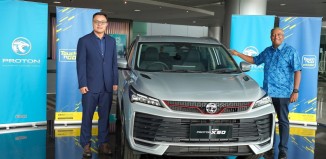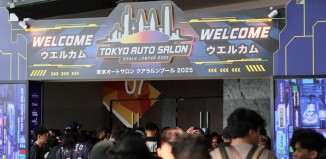The Third Mercedes in F1 GPs
Question: How many Mercedes cars are on the track in the F1 championship? Was your answer ‘two’? Wrong.
At each of the rounds in the past three years, there have been three cars bearing the famous Star of Stuttgart. Two of them are the ones the public has eyes on – with drivers Mika Hakkinen and David Coulthard on board. The third Mercedes is not always in the news but its presence is extremely important.
It is the F1 Safety Car provided by Mercedes-Benz (a second car is also on hand as reserve) and for this season, it has been a CL55 prepared by Mercedes-AMG. Driven by Bernd Maylander, a 29 year old pro racer himself, the F1 Safety Car has often led the pack of F1 racing machines around the circuit in the aftermath of an accident of in really bad weather conditions.
Although the F1 Safety Car appears during such situations, it is not , as a rule, a signal for the racing cars to slow down although they are required to maintain their positions. The Safety Car has to be able to maintain a fairly high speed as too low a speed would be fatal for the F1 engines in its slipstream which need sufficient cooling air otherwise they would overheat.
Maylander, who owns a Mercedes-Benz CLK himself, began driving his new ‘company car’ in March during the first round of the 2000 F1 season. He said that he was surprised by the superior driving dynamics and comfort of the exceedingly sporty and safe GT coupe.
The CL55 AMG is powered by an AMG V8 of 5.5 litres capacity and has been tuned to deliver 265 kW (360 bhp) with an imposing 530 Nm of torque. The AMG engine is a state-of-the-art powerplant with features such as a twin-pipe intake train, special variable intake manifold and race-specification forged pistons which are cooled by powerful oil injection nozzles. The characteristics of the 5-speed automatic gearbox with manual shift programs were also revised to meet the demands of the high-speed role.
But while the CL55 F1 Safety Car has impressed those who have driven it, the experienced motorsports engineers at Mercedes-AMG did not have to make a lot of changes to the car. The only alterations to the original CL500 production model involved giving the damping a sportier feel, lowering the suspension by 15 mm, widening the tracks and installing newly-developed 8-piston fixed-caliper brakes with larger discs.
Another key element retained from the production car is the Active Body Control (ABC), an active electro-hydraulically regulated suspension control system which minimises every kind of body roll. According to Maylander, ABC makes a significant difference to the safety of the car in any weather conditions.
“The technology allows lightning-fast lap times at GP circuits and I can drive the CL55 AMG at the limit, no problem,” he said. “And that is an indispensable qualification for a F1 Safety Car.”
The F1 Safety Car is typically brought to the race venue on the Tuesday before race day. Maylander arrives on Thursday and by 2 pm the same day, he is in the car in full racing gear. “We put the car through a thorough test on that day and for about an hour, I drive just below the limit,” he said. All systems are checked, especially the sophisticated communications inside and outside. There is one on-board camera and two others for exterior images. Two radio systems keep the crew in contact with Race Control. During the session, the circuit’s timing and top speed systems are also tested.
The light bar on the roof which resembles those on American police cars are among the more important features of the F1 Safety Car. There are green and orange lights; orange warns the racing drivers not to overtake at all while green signals that they can pass.
“Normally, the F1 Safety Car joins the track at the start/finish straight in front of the leading car. But that is not always possible, as in the case of Melbourne this year,” said Maylander. “A small error by race officials let the three leading cars shoot by. Mika had already entered the corner coming into the start/finish straight but we had to slow the other drivers down quickly and were told by Race Control to drive out in the middle of the field.”
Such a situation will confuse the race order because the leaders are in front of the Safety Car. This means that the other cars behind have to be allowed to pass it and the green light on the roof gives them that signal. Once the lead car is behind the Safety Car, the orange light goes on. There are also stroboscopic lights in the headlamp housings which, together with flashing rear lights, give neutral signals.
Race Day
Shortly before the race starts, Maylander gets the F1 Safety Car into position in the pit lane. He follows the start live on the on-board monitor of the COMAND system on the centre console. If something goes wrong at the start, Race Control will alert him to “stand by’, which means he has to fire up the engine and be ready to move into action. The marshals around the track wave yellow flags and display a white board with “SAFETY CAR” written on it to warn the racing drivers and that’s the time when Maylander gets onto the circuit.
Does being in front of the world’s fastest drivers have any effect on Maylander? No, he said, because it is his car that sets the pace. He slows down in areas where there has been an accident to ensure that the marshals can do their work safely and then accelerates up to 280 km/h (0 – 100 km/h can be achieved in 6 seconds) when past those areas. As soon as the track conditions are safe for racing, Race Control notifies Maylander to do the “last lap” .
“At this point, I turn the lights off. Usually, the lead driver will back off a bit so that he can dictate the pace while I turn off into the pit lane,” he said. As the cars head into the straight, the green flag is shown and the race is on again.
Besides supplying two units of the CL55 AMG, Mercedes-Benz also supplies a C-Class Stationwagon for the F1 Doctor which follows the cars as they roar off the starting line (so as to be present immediately if an accident occurs in the starting moments), a M-Class for the Clerk of the Course and a few other vehicles for official use. At European venues, members of the media can also get transportation around the circuit in a V-Class van.

























